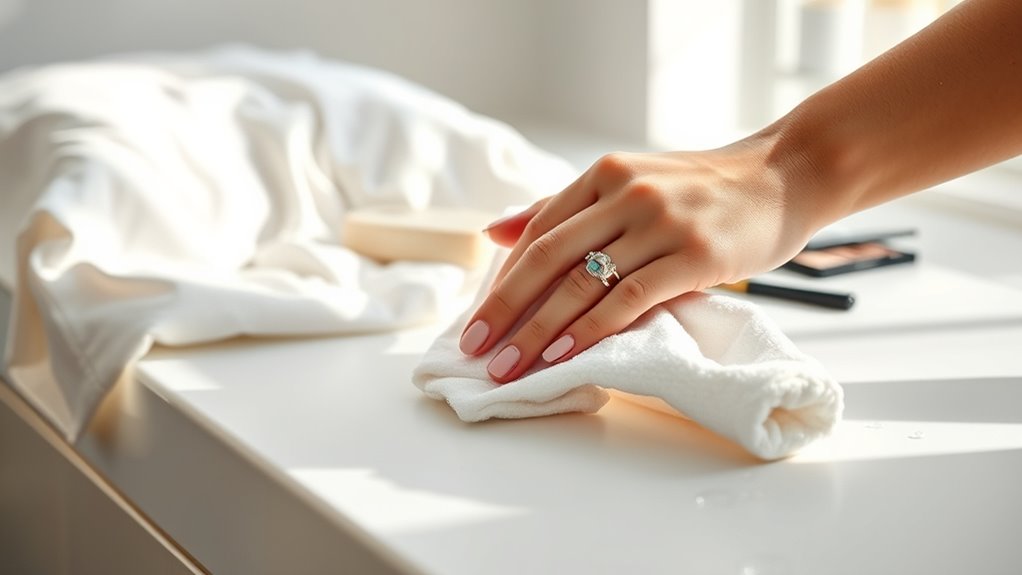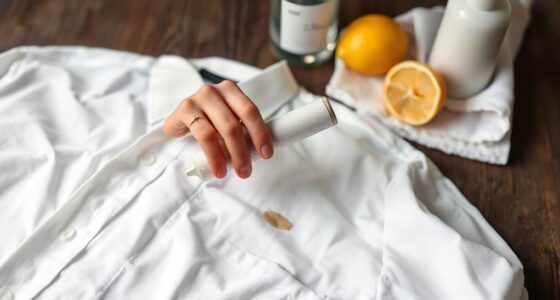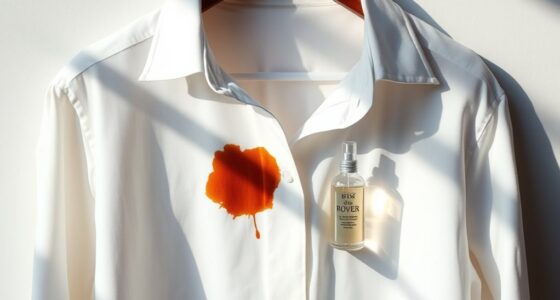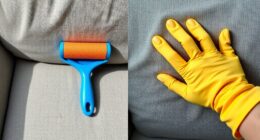To clean makeup stains from pillowcases and sheets, start by rinsing the stained area with cold water. For oil-based stains, gently blot with a cloth and apply a drop of dish soap. Treat water-based makeup by soaking in soapy water and using a microfiber cloth. For powder makeup, use a lint roller to lift the loose powder. Always air dry to prevent setting stains. Stick around for more tips on preventing future stains and effective cleaning techniques.
Key Takeaways
- Rinse stained areas of pillowcases and sheets with cold water immediately to prevent stains from setting.
- Blot excess makeup gently with a clean cloth before applying any cleaning solution.
- Use a mixture of gentle dish soap and water to treat oil-based makeup stains.
- For water-based stains, apply dish soap mixed with warm water using a microfiber cloth.
- Air dry completely after cleaning to avoid heat setting any remaining stains.
Assessing the Stain Type

How can you effectively identify the type of makeup stain you’re dealing with? Start by observing the stain’s characteristics.
Foundation stains are usually oil-based, requiring gentle removal methods. Lipstick stains, rich in oil and pigment, can be stubborn. Mascara and eyeliner stains often come from waterproof formulas, making them a bit trickier to tackle. If you see a powder makeup stain, you’re in luck—it’s generally easier to remove. Consider the fabric, too; delicate materials like silk need special care to avoid damage. Also, remember that the longer a stain sits, the harder it’ll be to remove. Common types of stains can help you assess the situation, guiding you toward the best approach for effective cleanup. By evaluating these elements, you can determine the best approach for effective cleanup.
Cleaning Oil-Based Makeup Stains
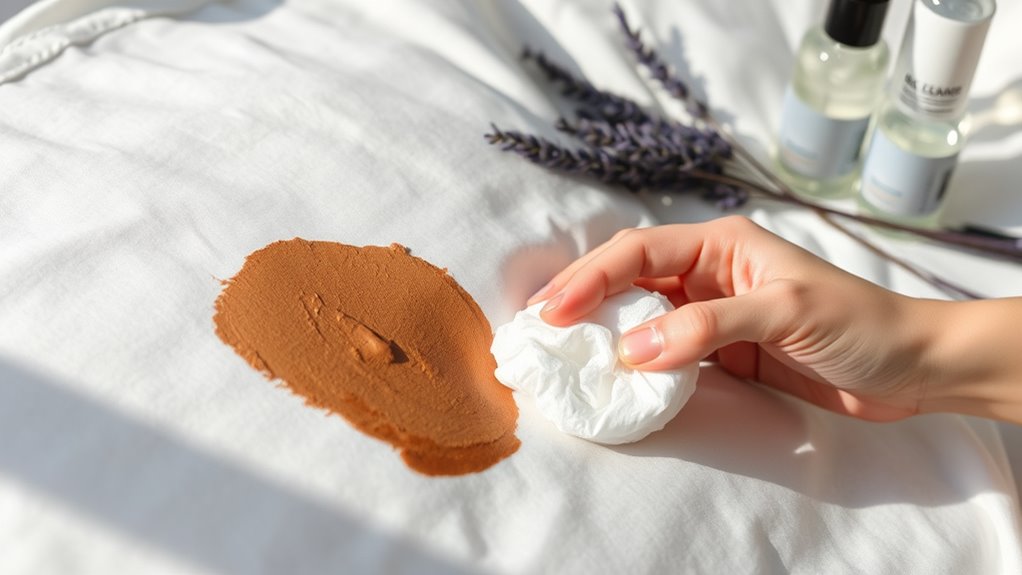
When you’re faced with an oil-based makeup stain, acting quickly can make all the difference in successfully removing it. Start by removing any excess makeup with a plastic spoon, then gently blot the stain with a clean cloth. For treatment, apply a drop of dish soap directly onto the stain and gently rub it in. Let it sit for 5-10 minutes before rinsing. Alternatively, soak cotton balls in rubbing alcohol and press them onto the stain to dissolve the oils. You can also create a baking soda paste for a gentle lift. If needed, use a commercial cleaner or pre-wash stain remover before washing. Always air dry your fabric to guarantee the stain is completely gone. Remember to always check the care label before using any stain removal method to ensure fabric safety.
Treating Water-Based Makeup Stains
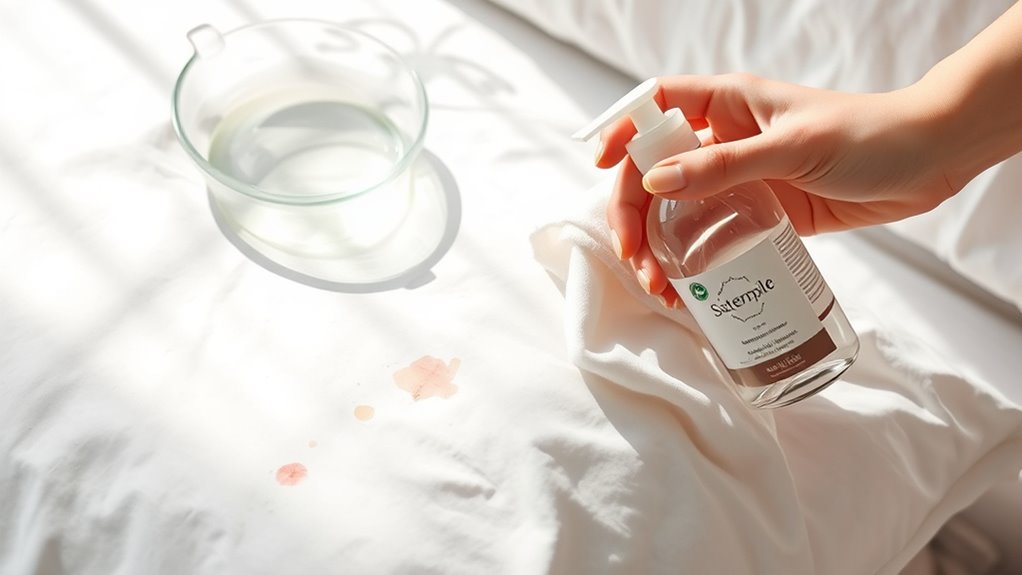
Oil-based makeup stains can be tricky, but water-based makeup stains are generally easier to tackle.
To start, gently blot the stain with a clean cloth to absorb excess makeup. Next, mix dish soap with warm water and apply it to the stain, using a microfiber cloth to blot gently. Additionally, use a pre-wash stain remover for semi-liquid makeup products to enhance cleaning effectiveness.
For tougher stains, soak the area in cold water for at least 30 minutes. After soaking, apply laundry detergent directly to the stain and work it in before rinsing with cold water.
Removing Powder Makeup Stains

Though removing powder makeup stains can feel intimidating, tackling them is often straightforward with the right techniques.
Start by using a lint roller to lift away any loose powder from your sheets and pillowcases. If you encounter caked-on makeup, gently scrape it off with a butter knife or credit card. Avoid rubbing the stain, as this can push it deeper into the fabric.
Instead, blot the area with a microfiber cloth to absorb any remaining powder. Always check the fabric care label before applying any cleaning solutions, and consider a gentle detergent mix for stubborn stains. Regular cleaning of bed sheets promotes health and better sleep, so don’t hesitate to repeat the process until the stain is gone. Remember, acting quickly makes all the difference!
Using Common Household Items
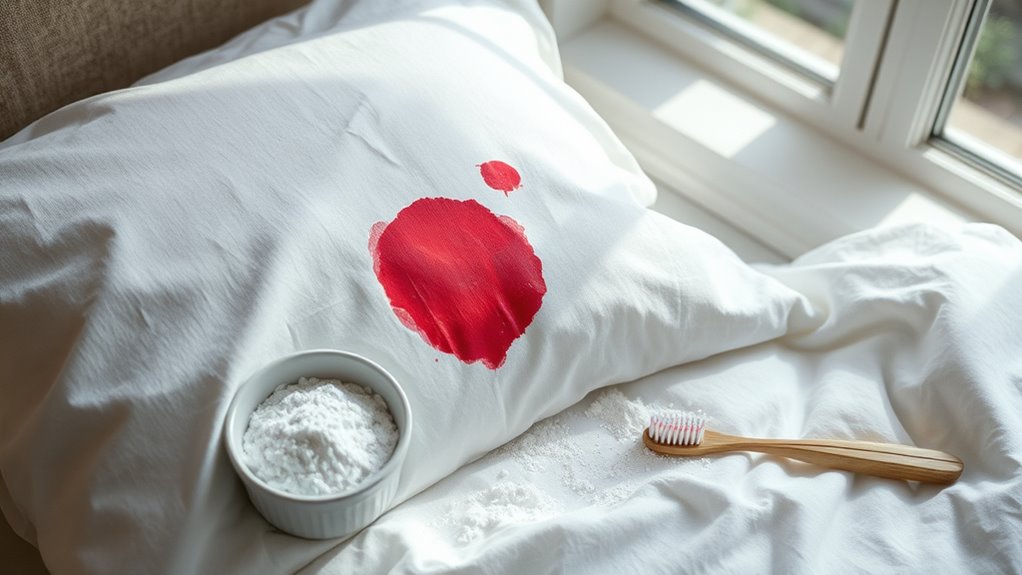
Cleaning makeup stains doesn’t have to be an intimidating task, especially when you can use common household items.
Start by applying a few drops of gentle dish soap directly to the stain or mix it with water for a soapy solution. Gently blot the stain with a clean cloth, working from the outside in, then rinse thoroughly with cold water. Pretreating the stain helps to effectively loosen the makeup before the washing process.
Alternatively, use shaving cream for liquid foundation stains. Apply it directly, let it sit for a few minutes, then dab with a damp cloth.
Hydrogen peroxide mixed with dish soap is another effective option. For oil-based stains, try isopropyl rubbing alcohol on cotton balls.
Always wash the fabric after treatment, and avoid the dryer until the stain is completely gone.
Spot Testing Before Cleaning
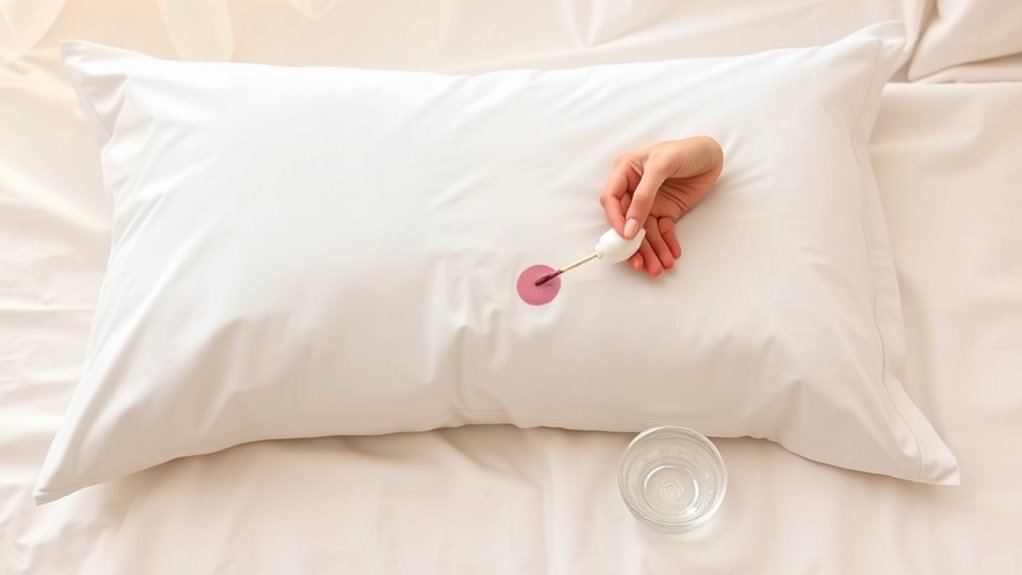
Before tackling any makeup stain, it’s essential to spot test your cleaning solution. This step guarantees that your chosen cleaner won’t damage or discolor your fabrics. Different materials, like silk or wool, react differently, so find an inconspicuous spot, such as under a seam or in a corner. Apply a small amount of the solution and let it dry completely. Check for any color change or texture damage. If the fabric remains unchanged, you’re likely safe to proceed. Keep in mind that factors like fabric composition and cleaning product concentration can influence the results. Proper spot testing protects your fabrics, preserves color, and saves you time and money in the long run. Additionally, waterproof and smudge-proof mascaras can leave tough stains, making spot testing even more crucial.
Preventing Future Stains
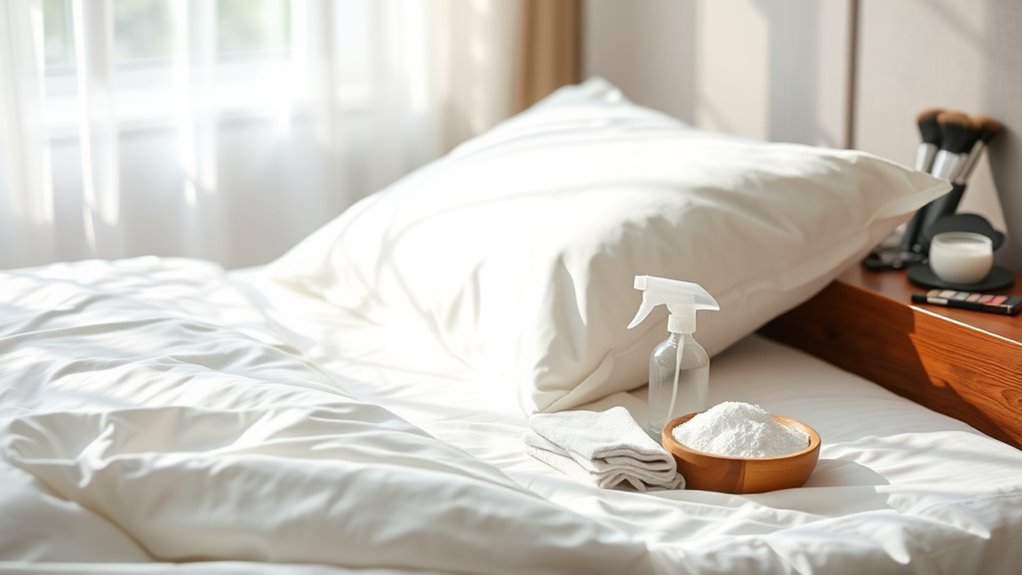
After ensuring your fabrics can withstand your cleaning solutions, it’s time to focus on preventing future stains from makeup.
Start by washing your sheets regularly to avoid any makeup buildup. Always remove your makeup before bed; this simple step greatly reduces stain risks. Additionally, be aware that older stains are tougher to remove, so addressing them promptly is essential. Incorporating a practice of nighttime meditation can also help you unwind and remember to prioritize your skincare routine. Implementing a routine similar to required minimum distributions can help ensure you consistently take the necessary steps towards maintaining your bedding. Establishing a bedtime routine can further enhance your nightly habits. Furthermore, advanced care planning for your skincare routine can help you choose products that are less likely to cause stains.
Regularly wash your sheets and always remove makeup before bed to significantly reduce the risk of stains.
Consider using protective coverings like pillowcases and sheet protectors to act as barriers. Treat your fabrics with stain guard products to repel makeup.
Choose materials like cotton or linen, which are easier to clean. Set up a designated makeup area to minimize spills and keep your makeup organized.
Finally, develop a consistent nighttime routine that includes makeup removal, ensuring you maintain a clean sleeping environment. Regular maintenance is key to keeping your bedding stain-free.
Steps to Take Immediately After a Stain Occurs
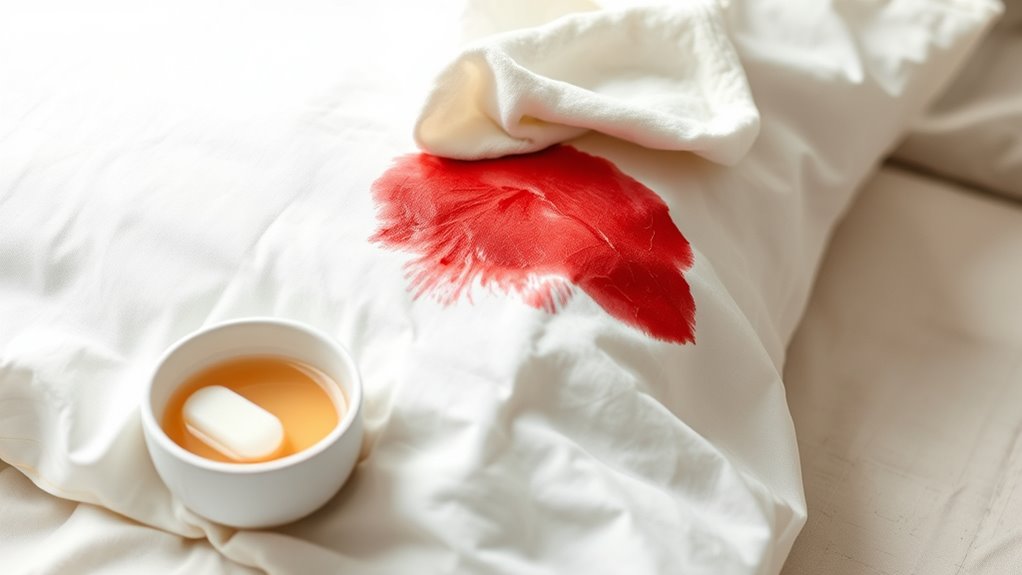
As soon as you notice a makeup stain, quick action can make all the difference in removing it completely. First, identify the type of stain—lipstick, mascara, or foundation. Blot the stain gently with a clean cloth or paper towel to remove excess makeup without rubbing. Next, run the stained area under cold water to prevent it from setting. If there’s caked-on makeup, use a spoon or butter knife to scrape it away carefully. Remember that blotting prevents makeup stains from worsening by lifting excess product. Before applying any cleaning solution, test it on an inconspicuous area to avoid damage. Gather your cleaning supplies and verify you review the fabric care label. Remember to work from the edges of the stain toward the center to contain it effectively.
Washing and Drying Tips for Stain-Free Bedding

Cleaning makeup stains promptly can save your bedding from lasting damage, but proper washing and drying techniques are just as important in ensuring they stay stain-free. Start by treating oily stains with a mix of gentle dish soap and water. Always wash in cold water to prevent setting the stains. Be sure to do a spot test on a hidden area first. Gently blot the stains instead of scrubbing. Remember that preventing makeup stains starts with a routine of washing your face before bed.
When it comes to drying, air dry your bedding completely; avoid the dryer until all stains are gone, as heat can set them deeper. Finally, check for any residual stains before drying and rinse thoroughly to eliminate soap residue. Follow the fabric care label for best results.
Frequently Asked Questions
Can I Use Bleach on Makeup Stains?
You can use bleach on makeup stains, but be cautious. Not all makeup types respond well to bleach, and it can damage certain fabrics.
If you decide to use it, always test on an inconspicuous area first to check for discoloration. Opt for oxygen-based bleaches like hydrogen peroxide for colored fabrics.
How Can I Remove Stubborn Stains After Multiple Washes?
When it comes to stubborn stains, think of them as a fierce opponent—you’ve got to outsmart them!
If multiple washes haven’t worked, try soaking the fabric in a mixture of warm water and a stain remover for at least 30 minutes.
Gently scrub the area with a soft brush, then rinse with cold water.
If the stain persists, don’t hesitate to repeat the process until you see victory!
What if I Can’t Identify the Stain Type?
If you can’t identify the stain type, start with a mild dish soap mixed with cold water.
Blot the area gently to lift excess residue. Always check the fabric care label before applying any treatment.
If the stain persists, consider using a makeup remover or diluted vinegar solution.
Remember to rinse with cold water to prevent setting the stain.
If all else fails, professional cleaning might be your best option.
Are There Specific Products to Avoid for Delicate Fabrics?
When dealing with delicate fabrics, you should avoid harsh chemicals like bleach and ammonia, as they can damage or discolor the material.
Instead, stick to gentle cleaners like baking soda or mild dish soap. Also, never rub stains; blotting is the safer method.
Remember, hot water can shrink or damage delicate fabrics, so always use cold water for rinsing.
If a stain persists, consider consulting a professional cleaner for help.
How Does Fabric Color Affect Stain Removal Methods?
Fabric color greatly impacts how you approach stain removal. On lighter fabrics, stains are more visible, so you might need stronger methods or products.
Conversely, darker fabrics can mask stains, allowing for gentler treatments. Always consider the type of stain and fabric; for instance, avoid bleach on colored materials.
Remember to spot test any cleaning solution first to guarantee it won’t damage or fade the fabric.
Conclusion
In the grand scheme of things, a little makeup mishap on your bedding isn’t the end of the world. With a few simple steps and some household items, you can easily restore your pillowcases and sheets to their pristine condition. By treating stains promptly and taking preventive measures, you can keep your bedding looking fresh and fabulous. So don’t fret over those makeup smudges; they’re just a minor detour on your journey to a beautifully maintained space!
